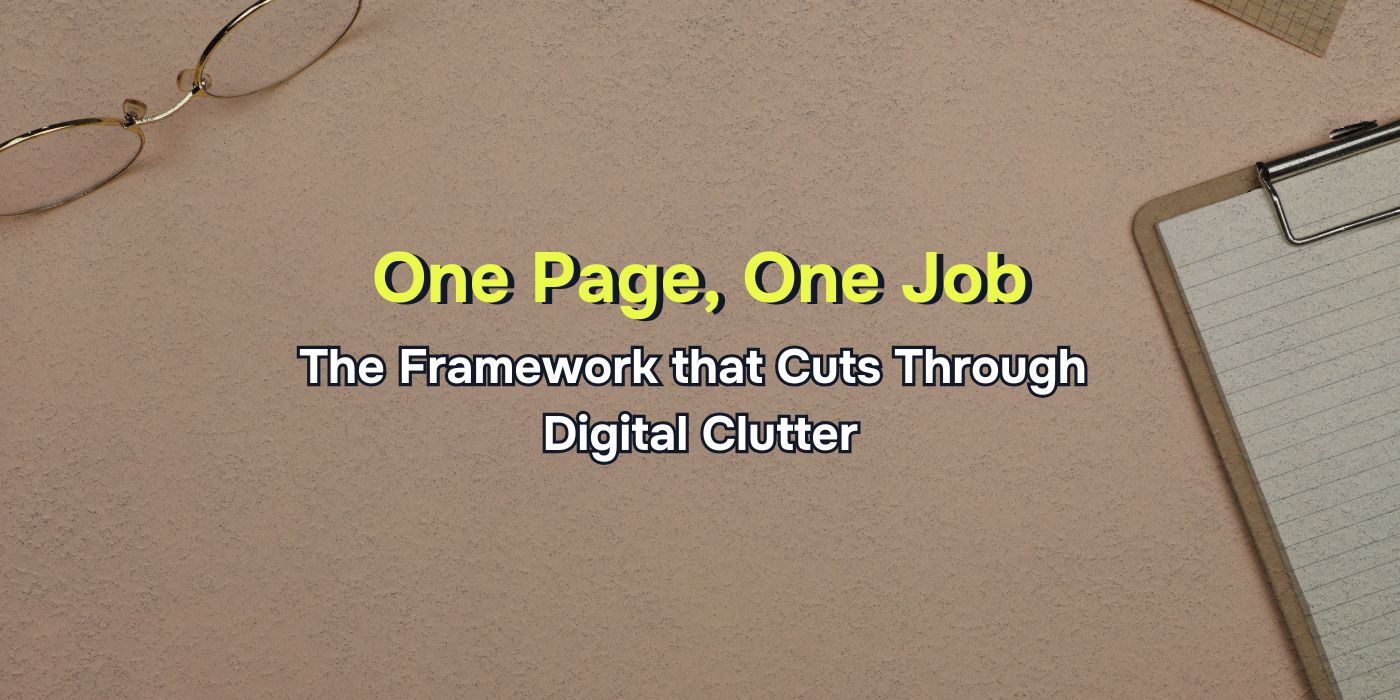Key Takeaways
- Every page needs one clear purpose.
If your page doesn’t have a single job, your visitor won’t know what to do next. - Remove anything that doesn’t support the page’s goal.
Extra CTAs, off-topic content, and visual clutter dilute performance. - Design and copy should revolve around one core action.
Build your layout to guide users toward that action — not away from it. - Simpler, focused pages convert better.
When visitors don’t have to think, they’re more likely to act.
If your website isn’t converting, there’s a good chance it’s trying to do too much at once.
One page is trying to sell and educate. Another is telling your company story while also pushing three services. Your blog posts bounce between thought leadership, lead gen, and brand building — all in one scroll.
It’s not that your content is bad. It’s that your pages are confused.
That’s where the “One Page, One Job” framework comes in. It forces clarity — by making sure every single page on your site has one clearly defined purpose, one core message, and one action it’s designed to drive.
Here’s how to apply it, why it works, and what to watch out for along the way.
What Does “One Page, One Job” Actually Mean?
It means that each page on your site should have exactly one reason to exist.
- A homepage introduces what you do and guides visitors to the right next step.
- A service page explains a single offering and invites people to take action.
- A landing page collects a lead — that’s it.
- A blog post answers a specific question or teaches one concept, not five.
When a page tries to do too many things — inform, sell, convert, educate, entertain — it does none of them well.
And worse, your visitor leaves unsure of what to do next.
How to Use This Framework (Step by Step)
Start by identifying the one job of each page. If you’re working on a service page, is the job to drive consultation bookings? If it’s a blog post, is it meant to explain a concept and guide readers to a related offer?
Be Decisive
A page can have supporting content, but its primary goal should be obvious — both to you and the visitor.
Be Intentional
Next, strip away anything that doesn’t serve that job. If you’re building a page to get people to request a quote, you don’t need a team gallery, a testimonial carousel, or three sidebar widgets. You need one focused message, one clear benefit, and one call to action that tells the visitor what happens next.
Design with Purpose
Once the content is streamlined, design around that single objective. Make the most important thing visually dominant. Guide the user’s eye from message to action without unnecessary choices or competing elements. Navigation menus, popups, or secondary CTAs should never pull attention away from the page’s main job.
Why It Works
This framework reduces cognitive load for your visitors. It removes guesswork, distraction, and ambiguity — which is exactly what leads to higher conversions, lower bounce rates, and better engagement.
It also makes your own job easier. When you build pages with a singular purpose, you don’t have to chase clarity later with longer copy, popups, or retargeting. The page does the work upfront — by doing less, but doing it better.
From an SEO perspective, it also improves relevance. Pages focused on one topic or intent tend to rank better, because search engines can clearly understand what the content is about and who it’s for.
What Most Marketers Get Wrong
Multitasking on Pages
They try to multitask on the page.
For example, a homepage that tries to be a sales page, culture page, and testimonial wall all at once ends up overwhelming the visitor. Or a service page that lists five different services, each with its own CTA, ends up with none of them converting.
Misaligning Content
Another common mistake is misaligning content with user intent. Someone reading a beginner’s guide blog post doesn’t want to “Book a Demo” yet. They want clarity — not commitment. Instead of pushing your end goal, match the CTA to where the visitor is in their journey.
Too Many Options
And finally, many marketers forget that too many options create paralysis. The more choices you give a user, the less likely they are to act. The “One Page, One Job” framework works because it removes unnecessary choices and focuses the page around one clear decision.
How to Audit Your Website with This Framework
Pick any page on your site and ask yourself:
- What is the one job of this page?
- Is that job obvious to someone landing here cold?
- Is every section, sentence, and design element helping that job succeed?
- Is there exactly one primary CTA — not multiple competing ones?
If you struggle to answer any of those, the page likely needs a rethink.
You don’t need a redesign. You need discipline. One page. One job.
Final Thought
Your website doesn’t need to say everything at once. It just needs to say the right thing at the right time.
By giving each page one purpose, one message, and one action, you reduce friction and increase trust — which is what drives real results. This isn’t about doing less for the sake of minimalism. It’s about doing less on purpose, so the thing that matters most actually gets through.
That’s how you turn a busy website into a high-performing one.
One page. One job. Every time.
FAQs
Can a page have more than one goal if they’re related?
It can support secondary goals, but one must be primary. If everything is equal priority, nothing is prioritized — and conversions suffer.
What if I need to explain multiple services on one page?
Use summaries and link out to dedicated service pages. Don’t try to sell every service in full detail on a single screen.
Does this apply to blog posts too?
Absolutely. Each blog post should cover one topic clearly and guide readers to one logical next step — not a menu of unrelated actions.





